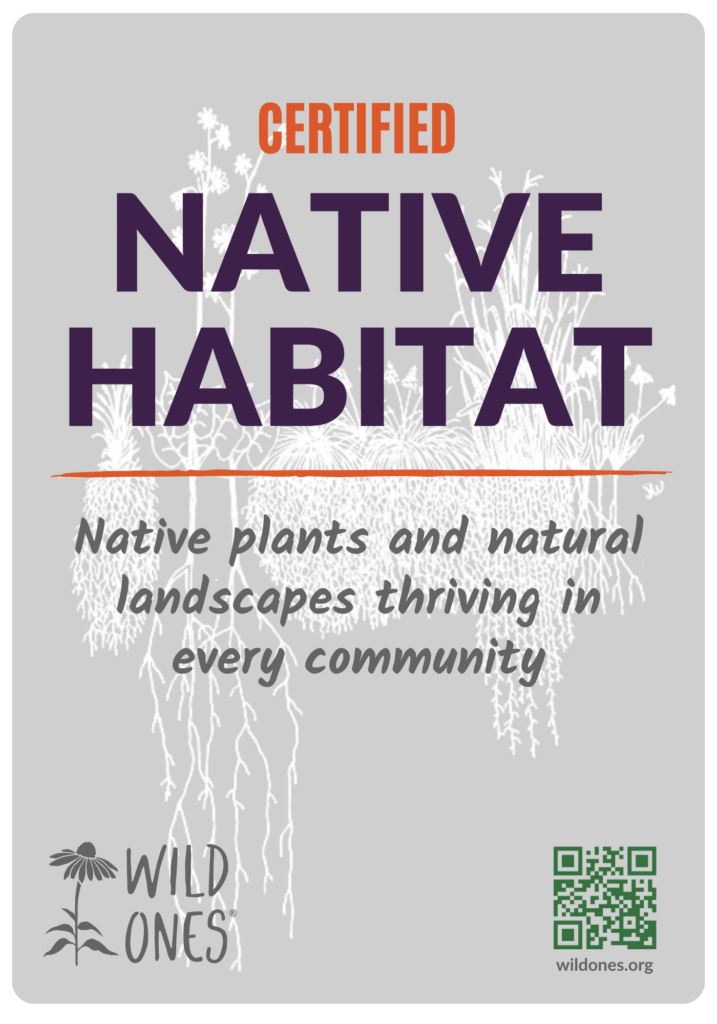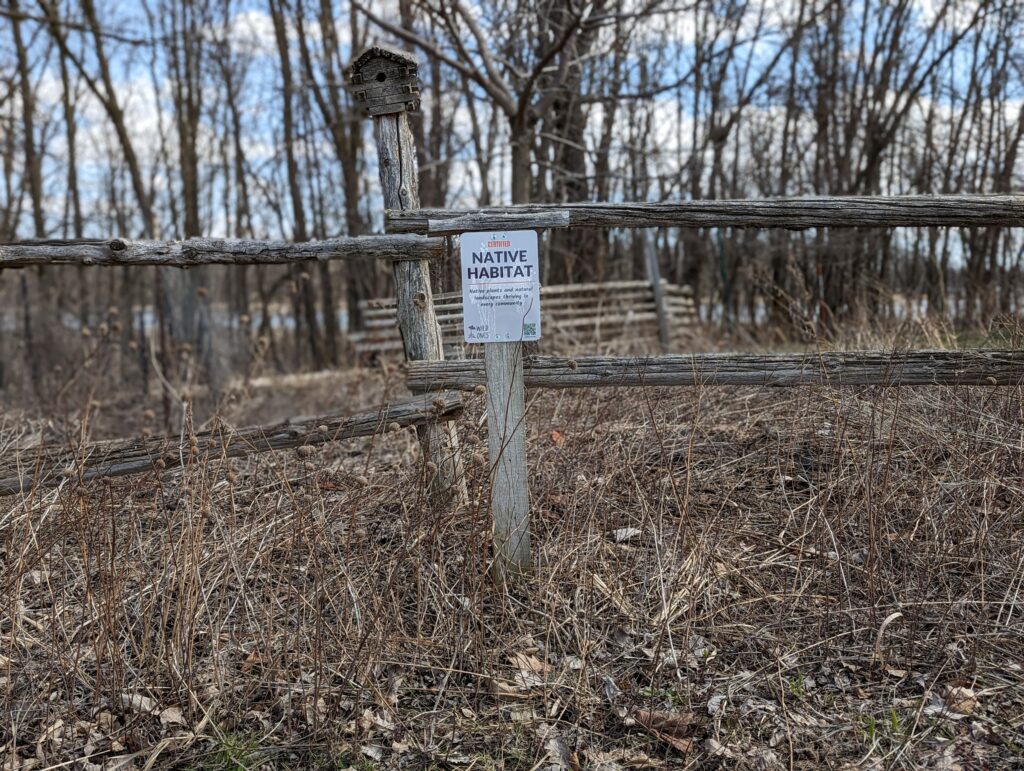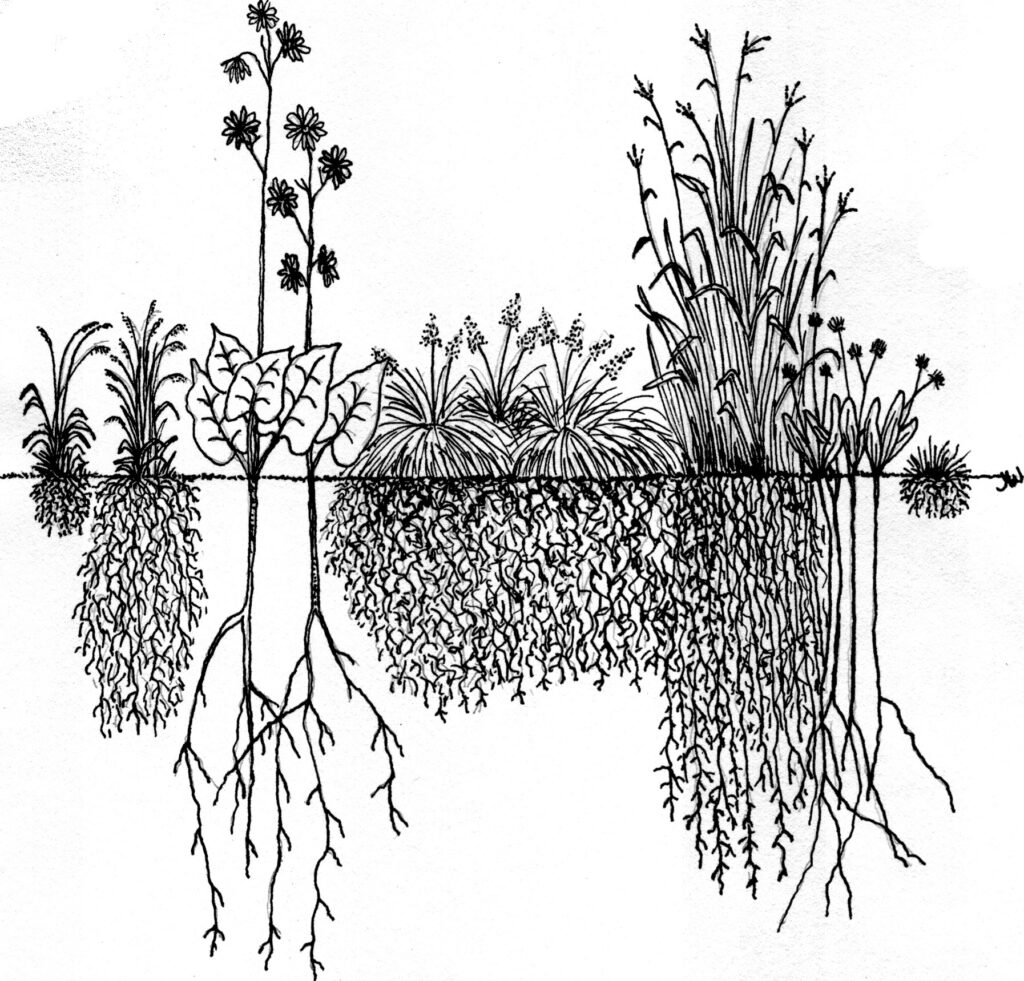Wild Ones is a community of native planters growing healthier landscapes. This program honors the dedication and hard work of members who actively participate in this transformative journey, recognizing their efforts as crucial contributions to environmental restoration and sustainability.
Embrace Native Landscapes. Display Your Commitment.
Wild Ones Certified Native Habitats are symbols of dedication to biodiversity, ecological restoration, and the nurturing of environments where native flora and fauna can thrive. Join Wild Ones in spreading the message and inspiring others, showcasing your habitat as a beacon of environmental stewardship.

Our Mission
Wild Ones envisions native plants and natural landscapes thriving in every community. We believe a healthy planet starts with native plants. Our Certified Native Habitat Signs are designed to celebrate and recognize the efforts of our members who share this vision, creating native gardens that serve as crucial habitats for local wildlife and pollinators. By displaying a sign, you not only mark your garden as a certified sanctuary but also become part of our larger movement towards healthier landscapes.
Why Display a Certified Native Habitat Sign?
- Recognition: Celebrate your hard work and dedication to maintaining a native habitat that contributes positively to the environment.
- Education: Inspire neighbors and community members by showcasing the impact of native gardening and habitat restoration.
- Support: Your certification fee supports Wild Ones’ mission to promote native landscapes through education, advocacy, and collaborative action.
Certification Criteria
To qualify for a Certified Native Habitat Sign, your garden should:
- Belong to an active Wild Ones member
- Be working towards a goal of at least 75% native plant species in your managed habitat area
- Support local wildlife and pollinators
- Follow regenerative gardening practices- these are environmentally conscientious approaches to managing and planting gardens and habitats
How to Register
- Certify Your Habitat: Before submitting your application, ensure your habitat meets our certification criteria above such as working towards a goal of at least 75% native plants and providing local ecosystem support.
- Submit your application: Complete your certification through our secure online platform. Wild Ones Habitat Certification is only open to Wild Ones members, so make sure to log in with your member account.
- Certify for a fee of $50. What you receive: The certification fee covers the cost of the certification process. As a token of our appreciation and to help promote awareness, you will also receive a sign for your garden that signifies your commitment to supporting native habitats.
Our Vision: 5,000 Gardens for the Wild
Wild Ones is starting a campaign to certify 5,000 Native Habitats! The “5,000 Gardens for the Wild” campaign envisions a network of Wild Ones member habitats that extends to a greater scale of environmental impact, where each native plant contributes to a larger, cohesive strategy for conservation and sustainability. Native habitats are critical stepping stones for wildlife and pollinators, promoting genetic diversity and offering refuge amidst urban sprawl. Wild Ones’ vision is native plants and natural landscapes thriving in every community and this is the movement to achieve that vision.
By achieving the milestone of 5,000 Certified Native Habitats, we aim to establish a legacy that resonates with Wild Ones vision of native plants and natural landscapes thriving in every community. This network will not only enhance the natural beauty of our neighborhoods but will also educate and inspire communities to prioritize native over non-native, and sustainable over ornamental. Our members’ Certified Native Habitats will stand as testaments to the role that every individual can play in preserving our planet’s biodiversity.
Join the Movement
Certifying your native habitat and displaying a Certified Native Habitat Sign is a step towards connecting with a community of like-minded individuals who are making a real difference. It is a declaration of your commitment to the environment and a call to action for others to join in the movement towards more sustainable living practices.
Join us in making a statement and a difference. Certify your garden today and be a proud part of a community dedicated to the celebration of native plants and natural landscapes. Together, we can inspire change, one garden at a time.

About the sign
Included with your certification, you will receive a garden sign to display your commitment to supporting native habitats. The graphic featured on the Certified Native Habitat sign is original artwork, “Roots” by Wild Ones Fox Valley Area Chapter member Janet Wissinic. The illustration depicts how native plants such as little bluestem (Schizachyrium scoparium), prairie dock (Silphium terebinthinaceum), prairie dropseed (Sporobolus heterolepis), and other herbaceous perennials have deep and extensive root systems while turf grass does not.

Long-time Wild Ones members might recognize this art from merchandise available in the early 2000s. Looking for new Wild Ones branded merchandise? Shop here.

How to display your sign
Choose the Right Location: Select a visible spot in your yard where the sign can be easily seen by passersby
Check for Underground Utilities: Always call before you start digging, make sure to check for any underground utilities. You can call your local utilities company to mark any underground lines to avoid damaging them.
Step-by-Step Instructions for Mounting:
- Mounting Your Sign with Screws.
- Tools and materials needed
- Sign (7″ wide x 10″ tall, four 3/8″ pre-drilled holes)
- Post
- Four #12 x 1 1/2″ stainless steel screws with pan heads and washers
- Drill and 1/8” drill bit
- Screwdriver or drill with screwdriver bit
- Level
- Instructions:
- Position the Sign: Hold the sign against the post. Use a level to check alignment.
- Mark Screw Holes: Mark through the sign’s holes onto the post.
- Pre-drill Holes: Drill pilot holes at the marks to prevent splitting.
- Attach the Sign: Align holes, then screw the sign to the post.
- Final Check: Ensure the sign is secure and adjust if necessary.
- Tools and materials needed
- Mounting Your Sign with Zip Ties
- Materials Needed
- Sign (7″ wide x 10″ tall, four 3/8″ pre-drilled holes)
- Two heavy-duty, UV-resistant zip ties (8-14 inches long)
- Scissors or zip tie cutter
- Suitable post or fence
- Instructions:
- Position the Sign: Hold against the post or fence.
- Attach Top Zip Tie: Thread through the top hole and around the post, tighten to secure, ensuring the sign is straight.
- Attach Bottom Zip Tie: Repeat for the bottom hole.
- Trim the Excess: Cut off extra zip tie ends.
- Final Check: Ensure the sign is secure and properly aligned.
- Materials Needed
